Limescale creeps silently into the washing machine, and by the time you notice it, it will have caused damage to the machine and even the laundry.
So on top of the lint, debris, and powerful detergents, you also have to be wary of limescale and what it can do to the washing machine.
The best way to remove limescale from the washing machine is to use a combination of lime or vinegar and baking soda. Some commercial descalers are also quite effective against limescale buildup.
- But what exactly is limescale, and why should you worry about its buildup inside the washer?
- More importantly, how do you remove it from every part of the machine?
Read on to find answers to all of these questions and more.
What is Limescale?
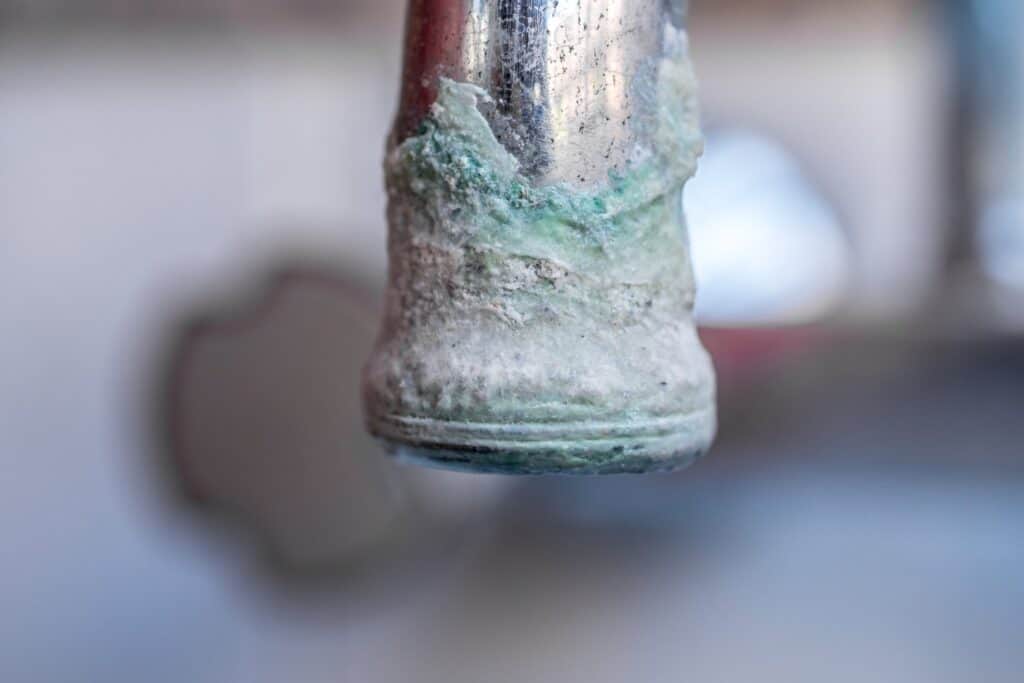
Limescale is the most dangerous of all the unwanted materials that build up inside the washer. It’s a white, chalky, and often hard substance that builds inside the drum and finds its way inside the heating parts, soap dispenser, and other vents and filters.
When the limescale reaches a certain level blocking the vents and filters can cause the machine to malfunction.
Apart from hard water, the main cause of limescale deposits is washing with low-temperature water and using liquid detergents or detergents for colors.
Unfortunately, these detergents don’t contain bleach, the first line of defense against limescale buildup.
Low temperature also allows the limescale to form little deposits in the corners. Hot water, on the other hand, liquefies the mineral and flushes it out.
At such a point, fixing it can be costly as just removing the limescale wouldn’t be enough. You’d most likely have to replace the damaged parts to make the washer work again.
Limescale is abundant in hard water. If you live in an area where hard water flows out of the tap, chances are your washer will have a buildup of limestone.
Although not toxic, limestone damages any appliances around the house that use water, such as the dishwasher, water heaters, showerheads, and faucets.
What does Limescale do to the Washing Machine and Laundry?
When the limescale reaches the heating parts of the washer, it starts to build up and cover them.
It also coats the sensors with a chalky layer that prevents them from getting the proper water temperature or even measuring the water levels in the drum accurately.
While cleaning the limescale buildup from the sensors is easy, the damage it causes to the heating parts can be so severe that you’d have to replace them.
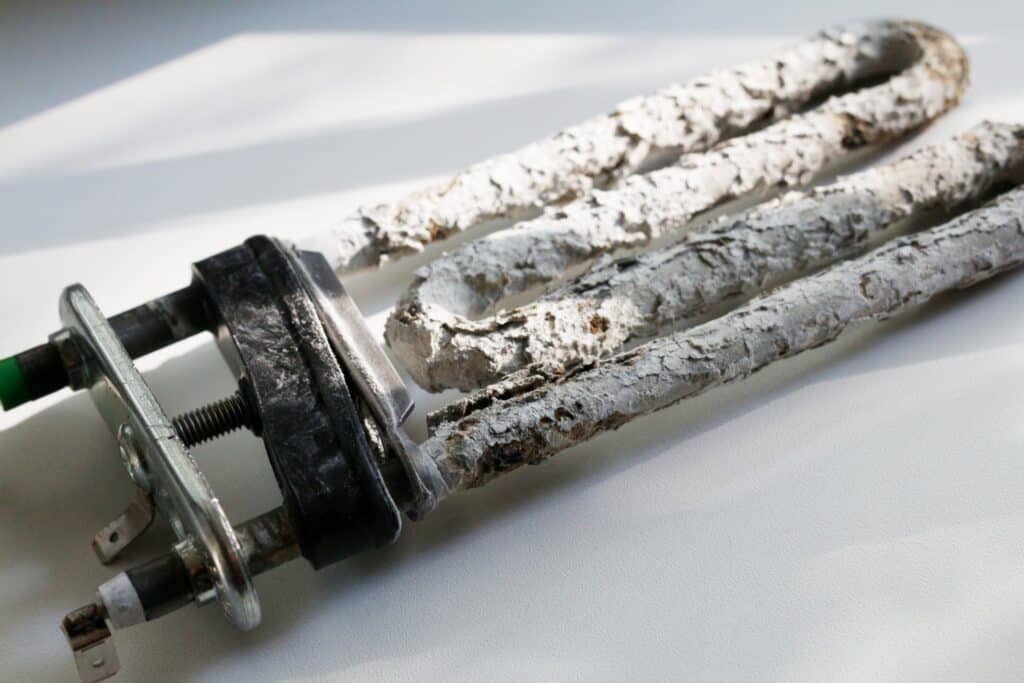
It’s also dangerous to the pipes, hoses, and even the drum itself. Unless the drum is made of stainless steel, chances are corrosion will set in and render it useless.
If your washer starts to leak more often, chances are the limescale buildup is causing erosion to the pipes and hoses.
Not to mention that the limescale is not fabric-friendly either. Its deposits in the texture of the clothes will cause them to become rough and abrasive.
People with sensitive skin would feel this abrasiveness faster than others.
How to Remove Limescale From Washing Machine
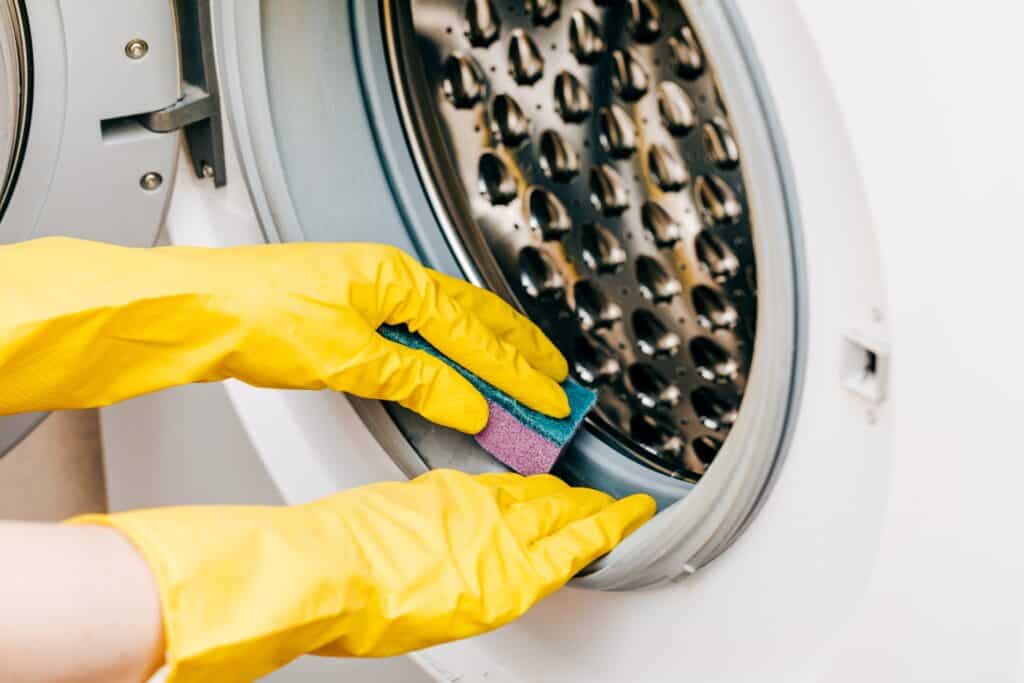
As is often the case, it’s easier to prevent the damage to the washing machine than to try to fix it after it happens.
When it comes to limescale buildup, the sooner you discover it and treat it, the better for the washer and the laundry.
In the following steps, we will give the drum and internal parts of the washer a thorough cleaning. The best part is that you will do just minimal cleaning. It’s the washer that will do all the heavy work.
Materials
- One cup of baking soda.
- One cup of white vinegar.
- Old toothbrush.
- Brush
- Washcloth
How to Do It
- Run the washer empty on a hot water cycle. Don’t add any detergents or fabric softeners. Just set it to the maximum temperature and water settings.
- When the washer is full of water, add a cup of baking soda to the water (for front-loading washers, add the baking soda to the detergent dispenser).
- Let the machine finish that cycle.
- Use a brush to scrub the inside of the drum where the limescale has built up. Wipe it clean with the washcloth.
- Dip the toothbrush in white vinegar and get it into the nooks and crannies that the brush cannot reach. Scrub the limescale deposits and wipe them with the washcloth.
- Start another cycle again with maximum temperature and water levels.
- Add a cup of white vinegar to the detergent dispenser and let the cycle finish.
- Repeat the scrubbing and wiping of the drum to get the last traces of the limescale off.
I also have a guide on how to remove limescale from your kettle that may interest you.
How to Descale the Washing Machine
While the above steps are pretty effective in removing limescale buildup from the drum, pipes, and hoses, you still need to remove it from the other parts of the washer that a wash cycle doesn’t usually reach.
Soap Drawer Limescale Cleaning
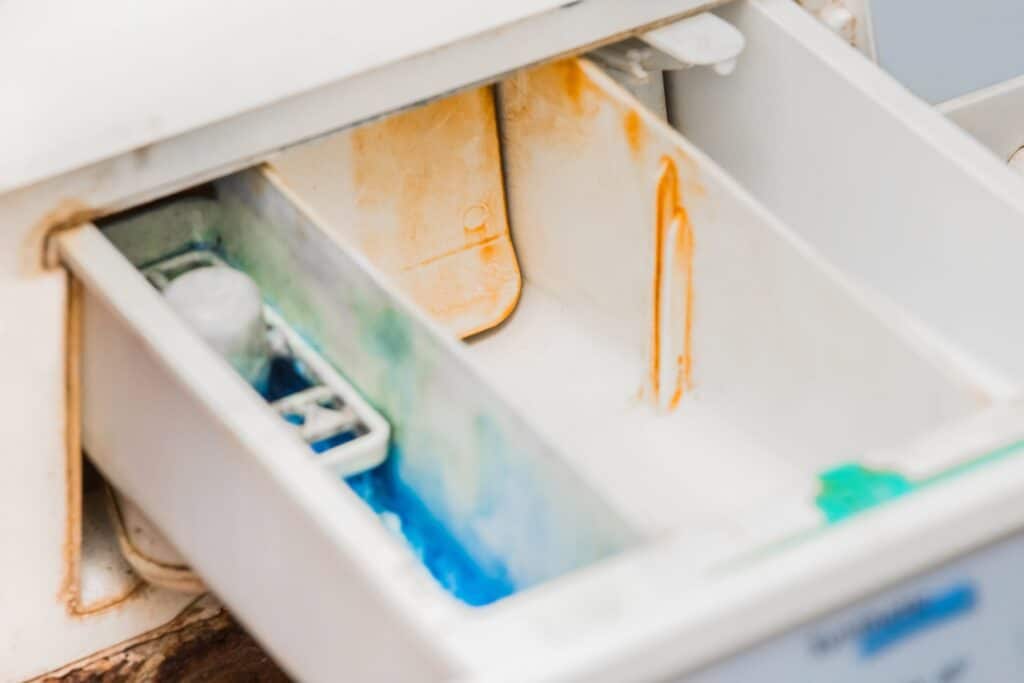
The soap or detergent drawer is one of the first places to look for limescale deposits. Experts recommend checking the detergent and fabric softener drawers regularly for traces of the damaging mineral.
If you find the deposits, then there’s a good chance limescale is already in the drum and heating parts of the washer.
Limescale deposits in the soap drawer come from two sources, the water jets that wash the detergent into the drum and the chemicals in the detergents themselves.
Before you clean the soap drawer, you need to pull it out.
Push the release tab or give the drawer a sharp tug to release it from the machine.
Check the siphon at the end of the drawer for traces of limescale deposits.
To clean the soap drawer, wait for the wash cycle to be over and the machine to power off, then pull the drawer out.
Use an old toothbrush and dip it in white vinegar.
Give the walls, corners, and bottom of the soap drawer a hearty scrub.
Wipe off the drawer with a wet washcloth, then finish off with another wipe with a dry washcloth.
Soap Dispenser Compartment Limescale Cleaning
Once you have cleaned the soap drawer, set it aside and turn your attention to the soap dispenser compartment. That’s the place in the washer where you fit the soap drawer.
Most likely, you’ll find grime there, but if you found limescale deposits in the drawer, then you’ll find it here too.
Since you don’t have as much maneuver room in the compartment as you had with the drawer, you’ll need to get a little creative to reach the deep corners of the compartment.
Instead of white vinegar, we’ll use bleach and water to dislodge the limescale deposits in the compartment. I recommend hydrogen peroxide, warm water, and a small brush with a long handle.
Dip the brush in the cleaning liquid and scrub the corners, walls, top, and bottom of the compartment.
Next, examine the dispenser jets at the top of the compartment. Here, you’ll find limescale deposits around the opening of the jets.
Use an old toothbrush to remove the calcified minerals and finish with a good wipe with a clean washcloth.
Now install the soap drawer back, and you’re done with this part of the washer. Next, you need to take a look inside the machine itself.
Limescale Inside Your Washing Machine
Although washers come in various shapes and sizes, the inside of the machine is more or less the same.
There’s a drum, sensors, filters, a pressure chamber, heating parts, and pipes and hoses leading in and out of the drum. Each one of those internal parts will need to be inspected regularly.
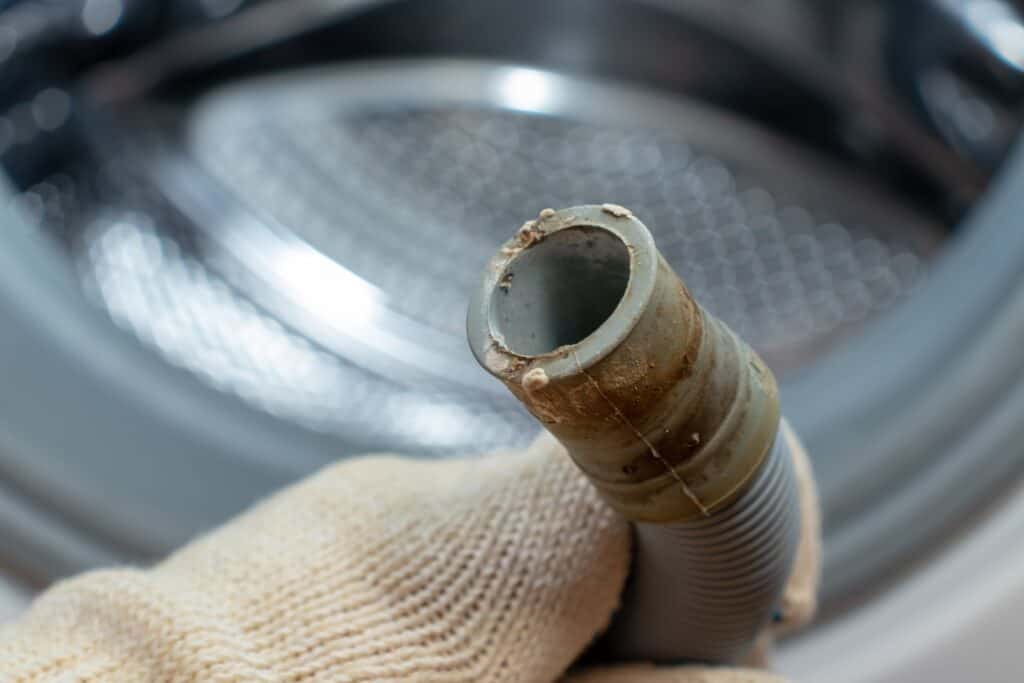
If you find deposits of limescale on any of these parts or if you have already scrubbed the mineral off the soap drawer and soap dispenser compartment, then you need to flush the limescale out of the machine.
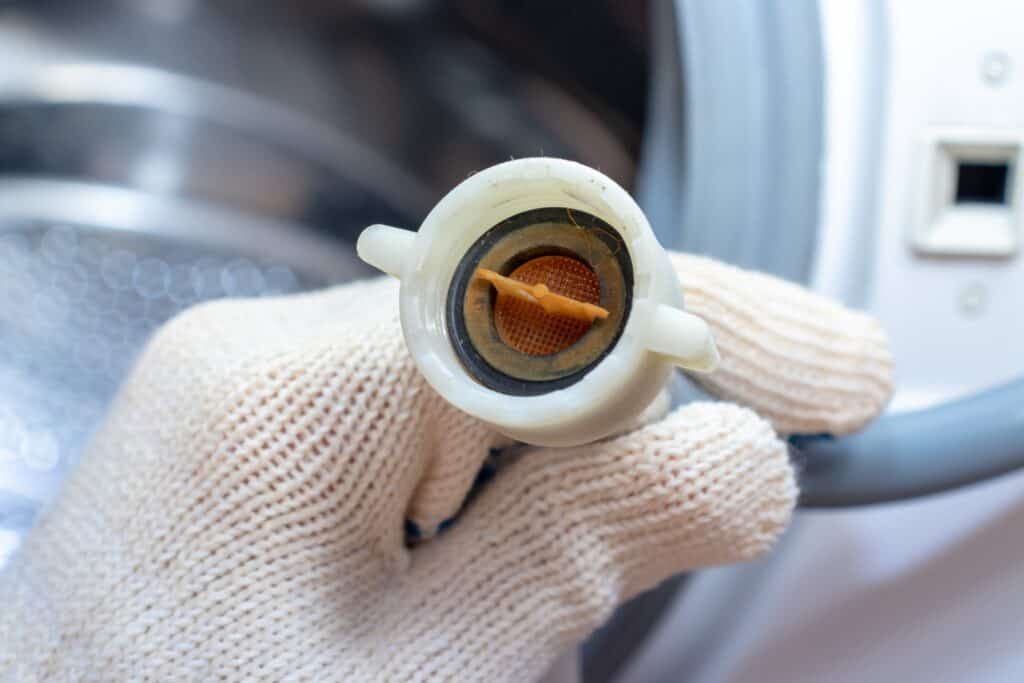
To do that, I recommend using a powder detergent that contains bleach.
Set the machine to drum clean cycle or if the washer doesn’t have that setting, just set it to the heavy-duty cycle.
Add one cup of powder detergent and choose the highest temperature setting available.
Start the washer.
You can also replace the powder detergent with any commercial lime descaler such as Lime-A-Way, Zep, and CLR Pro, among others.
Tips for Finding the Best Commercial Lime Descalers
While baking soda, white vinegar, and lime are cost-effective ways to remove limescale deposits from the washer, they’re not as efficient as commercial lime descalers.
But the market and Amazon are packed with different brands that all descale the washer with various degrees of success.
So how would you choose the best lime descaler for you? These tips will come in handy.
- Choose a lime descaler with natural ingredients. Harsh chemicals can cause damage to the internal parts of the washer.
- The product should specifically target limescale deposits, not just chemical deposits or grime buildup.
- The lime descaler should be versatile and works well with other appliances such as the dishwasher, water heater, showerheads, tubs, sinks, and other limescale targets.
- Make sure the product doesn’t leave any residue, and it should be water-soluble. If the lime descaler leaves a residue of its own, you’d be replacing one mineral deposit with another. Water solubility makes it easier for you to wash the liquid easily and rinse it with water.
- If you’re buying online, check user reviews of the product. This gives you an idea of whether the product works as advertised or not.
Here is a list of the best laundry detergents to use for hard water. Feel free to check it out as well.
FAQs
How often do I need to clean the limescale in my washing machine?
The frequency of regular maintenance of the washer depends on the water in the tap, the detergent you use, and how often you do your laundry. In general, you should give the washer a thorough wash once every month.
Check the soap drawer and soap dispenser compartment before you start your regular maintenance work. If you find deposits of limescale, then go ahead and give the wash a thorough lime descaling job.
If the washer is clean and limescale-free, you can clean the drum and give the lime descaling task another month or so.
What can I do to Prevent Limescale Buildup in my Machine between washes?
Limescale often has three sources: hard water, liquid detergents, or detergents for colors. Low water temperature also encourages the buildup of limescale in the washer.
So try to switch between liquid detergents and powder detergents that contain bleach every now and then. Avoid using detergents for colors all the time. They don’t have bleach.
Finally, you should use hot water every once in a while to do the laundry. If all your laundry requires warm water all the time, try to run the washer empty on high-temperature water after every 3 or 4 wash cycles.
This will flush the limescale deposits before they become a serious problem.
How can I Deal with Hard Water?
Hard water is beyond your control. What you can do, however, is find ways around it to minimize the damage hard water has on the washer and other appliances.
You can fit the washer with a hard water filter that prevents the heavy minerals and debris in the water from getting into the washer.
These filters work with most washers and need regular cleaning and maintenance. But it’s easier to remove limescale from the water filter than from the inside of the washer.
Water softening tablets are another solution for hard water. They dissolve the heavy minerals in the hard water and keep the internals of the washer clean and limescale-free.
Conclusion
Limescale is a destructive mineral that infiltrates the internal parts of the washer and the laundry itself. Limescale buildup can cause the water and temperature sensors to malfunction, and it could damage the heating parts of the machine.
To remove limescale deposits from the washer, you’ll need to run the machine empty twice with the maximum temperature setting. The first run will have baking soda, and the second will use white vinegar.
Next, you can check out my list of the best washers to buy if you have hard water.
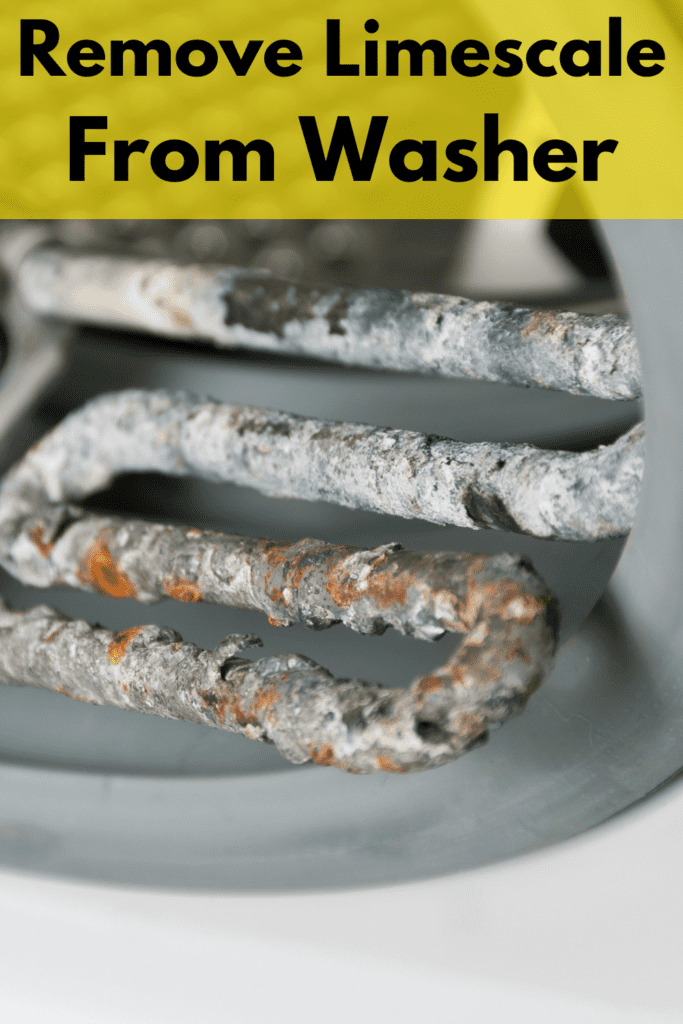

I’m an expert wardrobe organizer and a bit of a clean freak. I created this website and its YouTube channel to share practical guides about laundry and organizing. My teachings have been featured in multiple large news publications, and I’ve self-published two wardrobe organizing books and an entire course on the subject.

